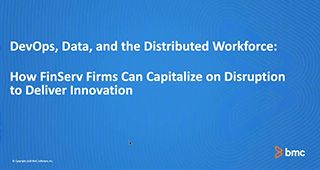There’s nothing quite like walking into a bank to make you realize how much our world has changed. Standing with my daughter, waiting to open her first account, I felt just how deeply the industry itself has transformed overnight. In the same breath, the change we’ve seen is likely just the tip of the iceberg.
That seed of an idea featured prominently in our recent chat with Stanford University professor and renowned futurist, Tim Chou. We sat down – virtually – for a candid chat about the kind of organizational transformation financial services is experiencing, and most importantly, how to turn that change into opportunity.
The disruption we’re seeing now is more than a moment in time. It’s a catalyst. You can adapt, or you can truly make something of it. How?
This pandemic is a chance to reframe challenges as new solutions. Whether you’re a traditional bank working in overdrive to create better digital experiences for your customer, or a FinTech start-up pivoting to ride the wave of economic shifts: the way we integrate technology, tools and software now is a lot like developing new muscles. Stretch them, flex them, use them. Doing so can help you spot gaps you didn’t know existed, or uncover opportunities to apply them in previously untapped ways.
Same goes for jumping on software development to provide much-needed enterprise-wide connections. As Tim pointed out, from FinTech start-ups to the world’s largest banks: financial services institutions are about as close to being software companies as any business can be. Shifting gears to get to market faster and smarter means first viewing the tools in your proverbial toolbox as a jumping off point for building something better. There’s huge potential in responding to market tumult with strategies reverse engineered from real pain points.
That’s equally true of the way you look at data. Having the right data strategy can drive benefits across functions, from customer experiences to cybersecurity programs. But simply mining the data is not enough. Especially now, you must mine and then refine that data into actionable, insightful plans that enable your team to run while you reinvent. Hitting sought-after status as a truly autonomous digital enterprise means knowing what your data means, and channeling that information into real steps that drive progress for your employees and customers. Doing it in short order can deliver the near-term results that enable you to keep on keeping on for the long haul.
Of course, none of this is possible if you haven’t teed your own people up to move the needle with you. Making the most of your systems and software to enable remote workers, keep them engaged, and cultivate the kind of culture that fuels innovation can’t be an after thought. Investing in the right tools for your internal folks matters just as much as investing in the right tools for your external customers. You can’t have one without the other.
And that’s really the key, isn’t it? Managing innovation doesn’t have to go on the back burner when things get tough. This is precisely when we need to redouble efforts to balance big ideas against budgets, resources, constraints, operational aspirations and time. Celebrating curiosity internally can spur innovation. Backing it up with the best tools can spur innovation that doesn’t just allow you to adapt to change; it fundamentally changes your bottom line.
That trip to the bank was a milestone moment I’ll remember for a number of different reasons. The smile on my daughter’s face as she made her first deposit, to be sure. But also because it was a tangible reminder that the financial services industry will no doubt emerge from the pandemic very differently, leaving me to wonder: what if it could emerge different and better?
Intelligent BMC Helix solutions such as BMC Helix Digital Workplace, BMC Helix Chatbot, and BMC Helix Business Workflows can help financial organizations streamline and automate their processes, delight their customers, and move business forward so they can not only survive but thrive as an Autonomous Digital Enterprise. For more information on capitalizing on disruption to deliver innovation, watch our webinar.
Watch the webinar: DevOps, Data and the Distributed Workforce
These postings are my own and do not necessarily represent BMC's position, strategies, or opinion.
See an error or have a suggestion? Please let us know by emailing blogs@bmc.com.







